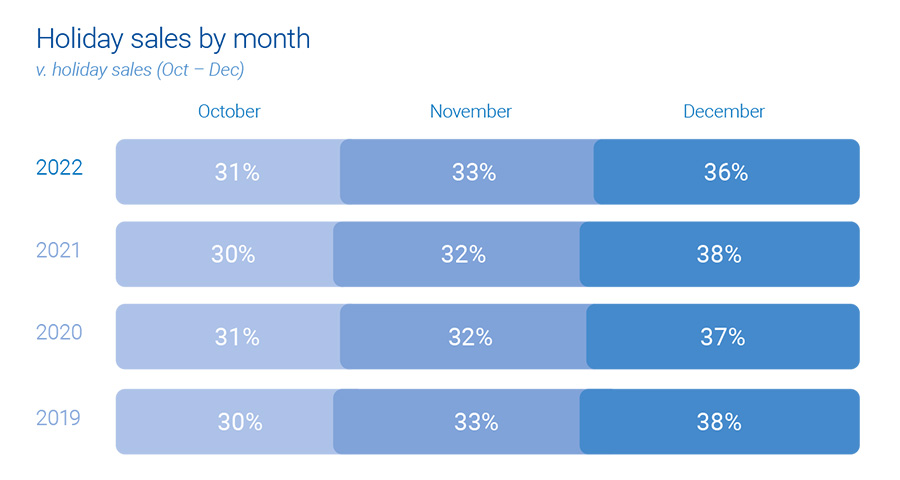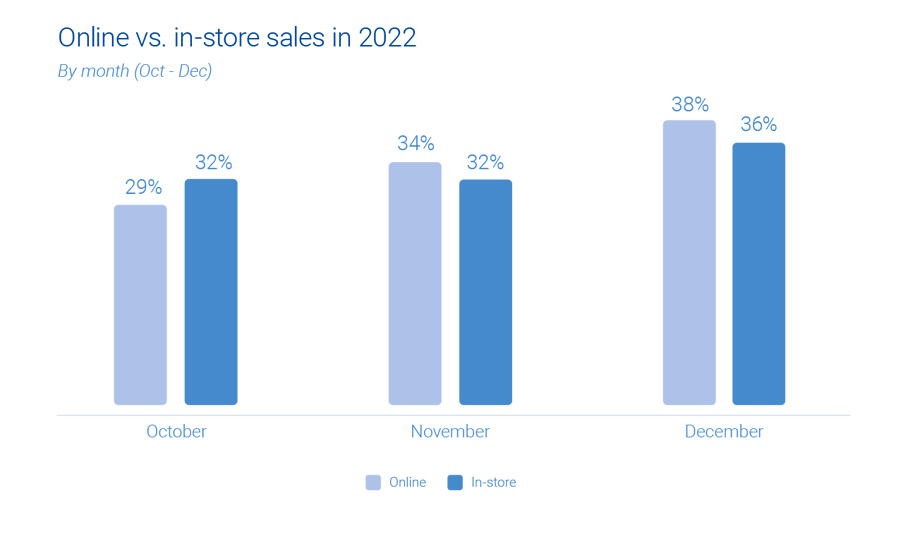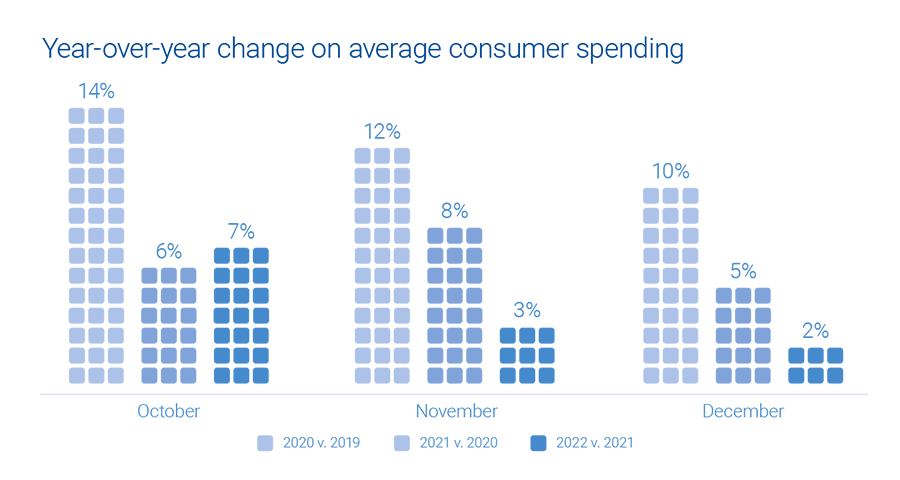
The holiday season is just around the corner, and retailers and marketers are gearing up for the busiest shopping period of the year. It’s crucial to understand how consumer behavior is evolving and what emerging trends to expect. Experian’s 2023 Holiday spending trends and insights report analyzes recent trends, consumer spending habits, and anticipates what’s to come in 2023 to help you deliver a top-notch shopping experience this holiday season.
In this blog post, we’ll cover three key insights from our report.
1. Consumers are shopping earlier
It’s no secret that December has always been the go-to month for consumers when it comes to holiday spending. However, holiday shopping now starts earlier, particularly with online sales.

This can be attributed to a surge in promotions and deals, enticing shoppers to open their wallets ahead of time, giving a significant boost to holiday sales. Notably, Cyber Week sales have proven to be an influential factor, accounting for 8% of total consumer holiday spending.
Experian tip
Reach the right shoppers with your promotions with sell-side targeting. This powerful approach gives you control over where your ads are placed while ensuring maximum visibility through direct connections with publishers. Whether on mobile, web, or CTV, this seamless ad experience will engage your audience effectively.
2. Online sales are on the rise
The popularity of online holiday sales is continuously growing, surpassing in-store shopping. There has been a consistent 1% year-over-year increase in online sales, while in-store sales have seen a 1% decrease.
“It’s easier for consumers to comparison shop for large ticket items online that they might find at a mass retailer or office supply store. Consumers prefer to have larger, bulkier items shipped directly to their home for minimal cost. By shopping online, consumers can save time since they don’t need to wait in checkout lines.”
Anna Liparoto, Sr. Account Executive, Retail & CPG

Although online sales currently make up only one-third of all holiday shopping, there is immense potential for further expansion. Mass retailers and office, electronics, and games industries particularly excel in online holiday sales. While in-store purchases remain the primary choice for holiday shoppers, consumer online and offline activities intersect before the final purchase.
Experian tip
Take advantage of the surge in online shopping by diversifying your marketing channels. An agnostic identity graph can bring together device and media data, capturing valuable user insights. By gaining a holistic view of your target audience, you’ll be able to optimize your ad spend and allocate resources effectively, ultimately boosting your return on investment.
“Omnichannel targeting during the upcoming holiday season will continue to prove to be the best way to reach scale and maximize ROI across all marketing channels.”
Joe LigÉ, Head of Enterprise Demand Partnerships
3. 2023 holiday spending will be on par with 2022
During the holiday season in 2022, consumer spending showed an anticipated increase, although the growth rate was slightly lower compared to previous years. October saw a surge in average consumer spending, indicating a swift response to early discounts and promotions offered by retailers.

As the holiday season progressed, holiday spending gradually slowed down and reached a level similar to that of the previous year. Overall, there was a modest 2% growth. Looking into the future, if economic conditions remain stable in the second half of 2023, we can expect holiday spending to align with the figures from last year.
Experian tip
To truly maximize impact, consider data enrichment. By diving deeper into your target audience’s preferences and behaviors, you can better tailor your strategies and seamlessly integrate the enriched data across various channels. This allows you to unlock the true potential of your ad inventory, creating more meaningful connections with your audience.
Download our 2024 report
Get ready for the holiday shopping season with Experian’s 2024 Holiday spending trends and insights report. Inside you’ll find:
- Analysis of past trends and what they mean for 2024
- Exclusive predictions for the upcoming holiday season
- The top audiences to activate this holiday season
To access to all of our predictions for this year’s holiday shopping season, download our 2024 Holiday spending trends and insights report today.
Latest posts

It is time for us to polish off our crystal ball and give our predictions straight from consumers’ fingertips for the hot products of the 2012 holiday season. Gadgets will reign across many ages Tablets including LeapPads, Tabeos, iPads, Kindles and others will continue to be a popular gift this year, with more choices than ever. On the list of top product-related search terms driving traffic to the Retail 500 category of sites, Kindle Fire HD and Windows 8 top the list as new products. Additionally, Meep!, a child friendly tablet appeared in the top fifteen. Accessories for both phones and tablets will also be popular, especially as the variety grows for iPhone 5 and iPad Mini. A reoccurring favorite gift for the holidays is UGGs which shows a decrease year over year. However, another brand with a similar product is Bearpaw, which is in the top ten searches and has seen big growth year over year. Source: Experian Hitwise Dolls, video games and Furbys, oh my! To identify the popular toys for gifts this year, we researched product-related search terms driving traffic to ToysRUs.com compared to last year’s holiday season. We uncovered trends in the doll category, Doc McStuffins as number one on the list, along with the classic Barbie, which saw a growth in searches year over year. The Furby is making a strong comeback at the number two spot with a reboot and new features. Another trend here is tablets, from branded searches like LeapPad and Kurio there is also the generic term ‘tablets for kids’. In the video game category, the new Wii U that is debuting just in time for Black Friday and should be a big gift this year, along with searches for PS3 games and the Nintendo 3ds xl are all in the top 20 searches. Source: Experian Hitwise Keywords of the consumer to identify demand Beyond product names, it is important to understand the actual way people search, using key phrases and questions. Last year, for example, there was a lot of activity around ‘in-stock’ products, such as the LeapPad explorer, which was hugely popular and quickly sold out in many stores. Retailers and marketers should monitor this throughout the season and make sure to optimize for in stock if there is a popular product that they have available. Source: Experian Hitwise Consumers also focus on what is the ‘best’ – so we see search activity around ‘best place to buy’, particularly around electronics. Questions such as ‘where to buy a’ specific product are also common, such as ‘where to buy a kindle’. These phrases offer opportunities to boost search campaigns by considering how consumers phrase their questions to ensure to capture these searches. Source: Experian Hitwise Quick tip: In the retail category there will tend to be a lot of retail branded store terms but to keep up with holiday search behavior and help make analysis quick, create portfolios of branded terms to easily exclude those from a certain category. When you strip out all the variations of that term you are able to gain insight into product searches that are most popular to a certain site or category. For more insight on the hot product trends for this year from our Hitwise trend-spotters, watch our webcast.

The holiday season – a most wonderful time of the year for retailers – is underway and marketers are tweaking their campaigns for better customer engagement and enchantment. There are many channels in which to reach top customers and prospective customers, and the new holiday season is a great time to refine strategies and tactics to ensure success. To help marketers in their quest, Experian Marketing Services recently conducted a market research study and learned that email marketing trumped all other tactics as the most successful initiative during the 2011 holiday season. Of the 84.2 percent who used email marketing, 95.8 percent reported that their campaigns were successful. Ninety-three percent said they planned to increase or maintain the same level of investment for the 2012 season. In addition to email, the study showed that paid search and online display advertising were the next most successful marketing tactics of the 2011 holiday season, with 48.9 percent naming search and 34.8 naming online display advertising as extremely or very successful campaign tactics. Our internal experts are currently looking at real-time data around these and other marketing channels and will present what they’ve learned during a live webinar on Thursday, October 25th at 1:00 p.m. EST. This information should prove very helpful to marketers who want to improve their campaigns based on current trends and results. Register for the holiday webinar and you’ll receive all of the survey data in the form of a 2012 holiday marketing white paper. Here’s to a joyous and profitable holiday season!

Experian Marketing Services pinpoints rising social network sites in new study – Instagram and Pinterest lead the pack According to a new study by Experian Marketing Services, niche social networks significantly increased their market share of all visits to social sites, with Instgram and Pinterest leading the pack. The following graph illustrates the global growth between July 2011 and July 2012, based on share of visits to all sites by country: Social site North America Australia Hong Kong New Zealand Singapore UK Instagram 17,319% 362% 132% 843% 8121% 2028% Pinterest 5124% 798% 2373% 643% 623% 1489% Other niche social networks that have experienced significant gain include Stock Twits in the US, Redidt in Australia, and FanPop in the UK. According to Bill Tancer, head of Global Research at Experian Marketing Services, the growth of Instagram and Pinterest over the past year has been successful because they haven’t tried to be ‘another Facebook.’ Both networks are image based – something people love and relate to better than just words. For retail brands, sites like Pinterest present a great opportunity to promote products in a compelling and organized way to a wide group of people, globally. Deeper functionally, combined with a lower technical barrier to entry, will result in new leaders in social media being created, accepted and used within a matter of days – compared to the rate of adoption happening now over the course of weeks and months. Also included in the study for July 2011 to July 2012: Country Social network Description Percentage increase of market share of visits to All Sites between July 2011 to July 2012 North America www.skillwho.com Social networking community which allow users to find people with skills from friends, friends of friends, local area or the community. 7435% increase http://stocktwits.com StockTwits is an open, community-powered investment idea and information service. 943% increase Australia www.reddit.com Site where users vote for what is popular or not. 177% increase Brazil Google+ Google+ integrates social services such as Google Profiles, and introduces new services identified as Circles, Hangouts and Sparks. 5750% increase New Zealand www.reddit.com Site where users vote for what is popular or not. 107% increase Singapore https://steamcommunity.com Community site that assists users in finding games to play, people to play against, and serves as a meeting place for friends and team mates. 124% UK Google+ Google+ integrates social services such as Google Profiles, and introduces new services identified as Circles, Hangouts and Sparks. 476% http://www.fanpop.com Network of fan clubs for fans of television, movies, music and more to discuss and share photos, videos, news and opinions with fellow fans. 178% What social networks do you use most frequently? Do the results of this study surprise you at all? Feel free to share your thoughts with our readers in the comments section below.